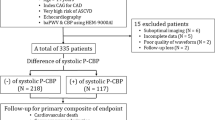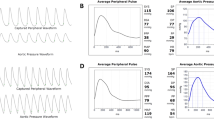Abstract
BACKGROUND:
Vascular endothelial dysfunction (VED) plays a pivotal role in the pathogenesis of atherosclerosis and is associated with insulin resistance and visceral obesity. We examined the predicting factors of VED in uncomplicated premenopausal obese women using analysis of endothelium-dependent vasodilation by radial artery pulse wave obtained through applanation tonometry.
METHODS:
The subjects included a group of 33 obese women body mass index ((BMI)≥25) and another age-matched control group of 25 nonobese women (BMI: 18.5–22.9) of Asian origin. All uncomplicated premenopausal (20–45 y) obese women were sedentary (<1 h/week of physical activity). Anthropometric measurements were performed, and regional distributions of adipose tissue and metabolic variables were measured. Endothelial function was measured by pulse wave analysis after salbutamol administration, which reflects endothelium-mediated vasodilation, contributed partially by nitric oxide release from β2-adrenergic stimulation. Radial artery wave forms were recorded and from a derived aortic wave forms augmentation index (AIx, defined as the pressure difference between the first and second peaks of the central arterial wave form, expressed as a percentage of the pulse pressure) was calculated. The subjects received sublingual nitroglycerine (NTG) (0.6 mg), followed by nebulized salbutamol (2.5 mg).
RESULTS:
AIx fell significantly after the administration of salbutamol, which causes endothelium-dependent vasodilatation. This value was significantly reduced in obese women compared with the controls (10.3±6.7 vs 17.2±6.8%, P=0.0003). NTG, which causes endothelium-independent vasodilatation, did not produce significant changes (P=0.917). As for our obese subjects, the visceral adipose tissue area was a significant predictor of VED independent of BMI, percent body fat, and other metabolic variables including high-sensitivity C-reactive protein (ß=−0.141, P=0.002, Adj-R2=0.41).
CONCLUSION:
Increased abdominal adiposity is a powerful independent predictor of VED in uncomplicated obese women. Further studies are warranted to determine the pathophysiological link between visceral adipose tissue and VED.
This is a preview of subscription content, access via your institution
Access options
Subscribe to this journal
Receive 12 print issues and online access
$259.00 per year
only $21.58 per issue
Buy this article
- Purchase on Springer Link
- Instant access to full article PDF
Prices may be subject to local taxes which are calculated during checkout

Similar content being viewed by others
References
Eckel RH, Krauss RM . American Heart Association call to action: obesity as a major risk factor for coronary heart disease. Circulation 1998; 97: 2099–2100.
Terry RB, Page WF, Haskell WL . Waist–hip ratio, body mass index and premature cardiovascular disease mortality in US Army veterans during a twenty-three year follow up study. Int J Obes Relat Metab Disord 1992; 16: 417–423.
Zamboni M, Armellini F, Sheiban I, De Marchi M, Todesco T, Bergamo Andreis IA, Cominacini L, Bosello O . Relation of body fat distribution in men and degree of coronary narrowing in cirinary artery disease. Am J Cardiol 1992; 70: 1135–1138.
Oppert JM, Charles MA, Thibult N, Guy-Grand B, Eschwege E, Ducimetiere P . Anthropometric estimates of muscle and fat mass in relation to cardiac and cancer mortality in men: Paris Prospective Study. Am J Clin Nutr 2002; 75: 1107–1113.
Ross R . Atherosclerosis—an inflammatory disease. N Engl J Med 1999; 340: 115–126.
Suwaidi JA, Hamasaki S, Higano ST, Nishimura RA, Holmes Jr DR, Lerman A . Long-term follow-up of patients with mild coronary artery disease and endothelial dysfunction. Circulation 2000; 101: 948–954.
Laine H, Yki-Jarvinen H, Kirvela O, Tolvanen T, Raitakari M, Solin O, Haaparanta M, Knuuti J, Nuutila P . Insulin resistance of glucose uptake in skeletal muscle cannot be ameliorated by enhancing endothelium-dependent blood flow in obesity. J Clin Invest 1998; 101: 1156–1162.
Steinberg HO, Chaker H, Leaming R, Johnson A, Brechtel G, Baron AD . Obesity/insulin resistance is associated with endothelial dysfunction: implications for the syndrome of insulin resistance. J Clin Invest 1996; 97: 2601–2610.
Arcaro G, Zamboni M, Rossi L, Turcato E, Covi G, Armellini F, Bosello O, Lechi A . Body fat distribution predicts the degree of endothelial dysfunction in uncomplicated obesity. Int J Obes Relat Metab Disord 1999; 23: 936–942.
Hashimoto M, Akishita M, Eto M, Kozaki K, Ako J, Sugimoto N, Yoshizumi M, Toba K, Ouchi Y . The impairment of flow-mediated vasodilatation in obese men with visceral fat accumulation. Int J Obes Relat Metab Disord 1998; 22: 477–484.
Cockcroft JR, Wilkinson IB, Webb DJ . Endothelial dysfunction. In: John C, Jonathan G (eds) Diabetes—Current Perspectives, 1st edn. Martin Dunitz Ltd: London; 1999. pp 141–164.
Wilkinson IB, Hall IR, MacCallum H, Mackenzie IS, McEniery CM, van der Arend BJ, Shu YE, Mackay LS, Webb DJ, Cockcroft JR . Pluse-wave analysis: clinical evaluation of a noninvasive, widely applicable method for assessing endothelial function. Arterioscler Thromb Vasc Biol 2002; 22: 147–152.
Dawes M, Chowienczyk PJ, Ritter JM . Effects of inhibition of the L-arginine/nitric oxide on vasodilation caused by beta-adrenergic agonist in forearm. Circulation 1997; 95: 2293–2297.
Chowienczyk PJ, Kelly RP, MacCallum H, Millasseau SC, Andersson TL, Gosling RG, Ritter JM, Anggard EE . Photoplethysmographic assessment of pluse wave reflection: blunted response to endosthelium-dependent beta2-adrenergic vasodilation in type II diabetes mellitus. J Am Coll Cardiol 1999; 34: 2007–2014.
Lind L, Pettersson K, Johansson K . Analysis of endothelium-dependent vasodilation by use of the radial artery pulse wave obtained by applanation tonometry. Clin Physiol Funct Imaging 2003; 23: 50–57.
Anderson TJ, Uehata A, Gerhard MD, Meredith IT, Knab S, Delagrange D, Lieberman EH, Ganz P, Creager MA, Yeung AC . Close relation of endothelial function in the human coronary and peripheral circulations. J Am Coll Cardiol 1995; 26: 1235–1241.
Rajagopalan S, Brook R, Rubenfire M, Pitt E, Young E, Pitt B . Abnormal Brachial artery flow-mediated vasodilation in young adults with major depression. Am J Cardiol 2001; 88: 196–198.
Matthews DR, Hosker JP, Rudenski AS, Nalyor BA, Treacher DF, Turner RC . Homeostasis model assesment: insulin resistance and beta-cell funtion from fasting plasma glucose and insulin concentration in man. Diabetologia 1985; 28: 412–419.
Davies JI, Struthers AD . Pulse wave analysis and pulse wave velocity:a critical review of their strengths and weaknesses. J Hypertens 2003; 21: 463–472.
Karamanoglu M, O’Rourke MF, Avolio AP, Kelly RP . An analysis of the relationship between central aortic and peripheral upper limb pressure waves in man. European Heart Journal 1993; 14: 160–167.
Takazawa K, O’Rourke MF, Fujita M, Tanaka N, Takeda K, Kurosu F, Ibukiyama C . Estimation of ascending aortic pressure from radial arterial pressure using a generalized transfer function. Z Kardiol 1996; 85 (Suppl 3): 137–139.
Chen CH, Nevo E, Fetics B, Pak PH, Yin FC, Maughan WL, Kass DA . Estimation of central aortic pressure waveform by mathematical transformation of radial tonometry pressure. Validation of generalized transfer function. Circulation 1997; 95: 1827–1836.
Wilkinson IB, MacCallum H, Flint L, Cockcroft JR, Newby DE, Webb DJ . The influence of heart rate on augmentation index and central arterial pressure in humans. J Physiol 2000; 525: 263–270.
Seger P, Qasem A, DeBacker T, Carlier S, Verdonck P, Avolio A . Peripheral ‘oscillatory’ compliance is associated with aortic augmentation index. Hypertension 2001; 37: 1434–1439.
O’Rourke MF, Kelly RP, Avolio AP . The arterial pulse. Lea & Febiger: Pennsylvania, USA; 1992.
Mackenzie IS, Wilkinson IB, Cockcroft JR . Assessment of arterial stiffness in clinical practice. Q J Med 2002; 95: 67–74.
Filipovsky J, Svobodova V, Pecen L . Reproducibility of pulse wave analysis in healthy subjects. J Hypertens 2000; 18: 1033–1040.
Wilkinson IB, Fuchs SA, Jansen IM, Spratt JC, Murray GD, Cockcroft JR, Webb DJ . Reproducibility of pulse wave velocity and augmentation index measured by pulse wave analysis. J Hypertens 1998; 16: 2079–2084.
Brook RD, Bard RL, Rubenfire M, Ridker PM, Rajagopalan S . Usefulness of visceral obesity in predicting vascular endothelial function in healthy overweight adults. Am J Cardiol 2001; 88: 1264–1269.
Skouby SO, Gram J, Anderson LF, Sidelmann J, Petersen KR, Jespersen J . Hormone replacement therapy: estrogen and progestin effects on plasma C-reactive protein concentrations. Am J Obestet Gynecol 2002; 186: 969–977.
Brooks-Asplund EM, Tupper CE, Daun JM, Kenney WL, Cannon JG . Hormone modulation of interleukin-6, tumor necrosis factor and associated receptor secretion postmenopausal women. Cytokine 2002; 19: 193–200.
Steinberg HO, Tarshoby M, Monestel R, Hook G, Cronin J, Johnson A, Bayazeed B, Baron AD . Elevated circulating free fatty acid levels impair endothelium-dependent vasodilatation. J Clin Invest 1997; 100: 1230–1239.
Mohamed-Ali V, Goodrick S, Rawesh A, Katz DR, Miles JM, Yudkin JS, Klein S, Coppack SW . Human subcutaneous adipose tissue release IL-6 but not tumor necrosis factor-alpha, in vivo. J Clin Endocrinol Metab 1997; 82: 4196–4200.
Jang Y, Lincoff M, Plow EF, Topol EJ . Cell adhesion molecules in coronary aretery disease. J Am Coll Cardiol 1994; 24: 1591–1601.
Bhagat K, Balance P . Inflammatory cytokines impair endothelium-dependent dilatation in human vein in vivo. Circulation 1997; 96: 3042–3047.
Heinrich PC, Castell JV, Andus T . Interleukin-6 and the acute phase response. Biochem J 1990; 265: 621–636.
Muniyappa R, Walsh MF, Sowers JR . The role of IGF-1 and effect of insulin on the vascular wall. Nutr Metab Cardiovasc Dis 1997; 7: 86–91.
Aljada A, Dandona P . Effect of insulin on human aortic endothelial nitric oxide synthase. Metabolism 2000; 49: 147–150.
Zeng G, Quon MJ . Insulin-stimulated production of nitric oxide is inhibited by wortmannin. J Clin Invest 1996; 98: 894–898.
Aljada A, Ghanim H, Assian E, Dandona P . Tumor necrosis factor-alpha inhibits insulin-induced increase in endothelial nitric oxide synthase and reduced insulin receptor content and phosphorylation in human aortic endothelial cells. Metabolism 2002; 51: 487–491.
Garg R, Kumbkarni Y, Aljada A, Mohanty P, Ghanim H, Hamouda W, Dandona P . Troglitasone reduces reactive oxygen species generation by leukocytes and lipid peroxidation and improves flow-mediated vasodilatation in obese subjects. Hypertension 2000; 36: 430–435.
Wilkinson IB, Mac Callum H, Hupperetz PC, van Thoor CJ, Cockcroft JR, Webb DJ . Changes in the derived central pressure waveform and pulse pressure in response to angiotensin II and noradrenaline in man. J Physiol 2001; 530: 541–550.
Tripathy D, Aljada A, Dandona P . Free fatty acids (FFA) and endothelial dysfunction: role of increased oxidative stress and inflammation-to: Steinberg et al. (2002) vascular function, insulin resistance and fatty acids. Diabetologia 2003; 46: 300–301.
Pleiner J, Schaller G, Mittermayer F, Bayerle-Eder M, Roden M, Wolzt M . FFA-induced endothelial dysfunction can be corrected by vitamin C. J Clin Endocrinol Metab 2002; 87: 2913–2917.
Dandona P, Mohanty P, Ghanim H, Aljada A, Browne R, Hamouda W, Afzal A, Garg R . The suppressive effect of dietary restriction and weight loss in the obese on the generation of reactive oxygen species by leukocytes, lipid peroxidation, and protein carbonylation. J Clin Endocrinol Metab 2001; 86: 355–362.
Verma S, Wang CH, Li SH, Dumont AS, Fedak PW, Badiwala MV, Dhillon B, Weisel RD, Li RK . C-reactive protein attenuates nitric oxide production and inhibits angiogenesis. Circulation 2002; 106: 913–919.
Acknowledgements
The pulse analyzer (Pulse Wave Analysis, SphygmoCor) used in the present study was donated by AtCor Medical Pty Ltd. The present study was funded by a research grant provided by Ewha Womans University.
Author information
Authors and Affiliations
Corresponding author
Rights and permissions
About this article
Cite this article
Suh, HS., Park, YW., Kang, JH. et al. Vascular endothelial dysfunction tested by blunted response to endothelium-dependent vasodilation by salbutamol and its related factors in uncomplicated pre-menopausal obese women. Int J Obes 29, 217–222 (2005). https://doi.org/10.1038/sj.ijo.0802642
Received:
Revised:
Accepted:
Published:
Issue Date:
DOI: https://doi.org/10.1038/sj.ijo.0802642
Keywords
This article is cited by
-
Vasoreactivity is rapidly improved in obese subjects after gastric bypass surgery
International Journal of Obesity (2009)



